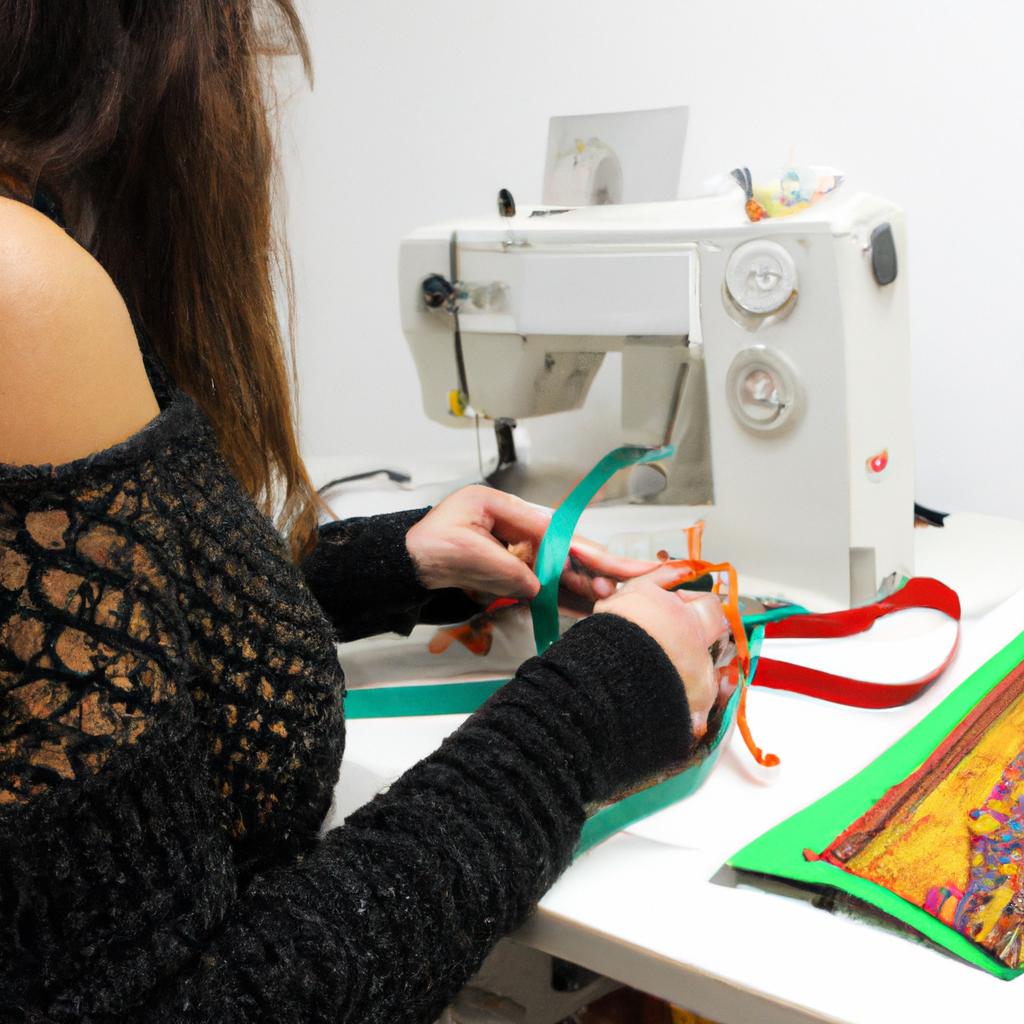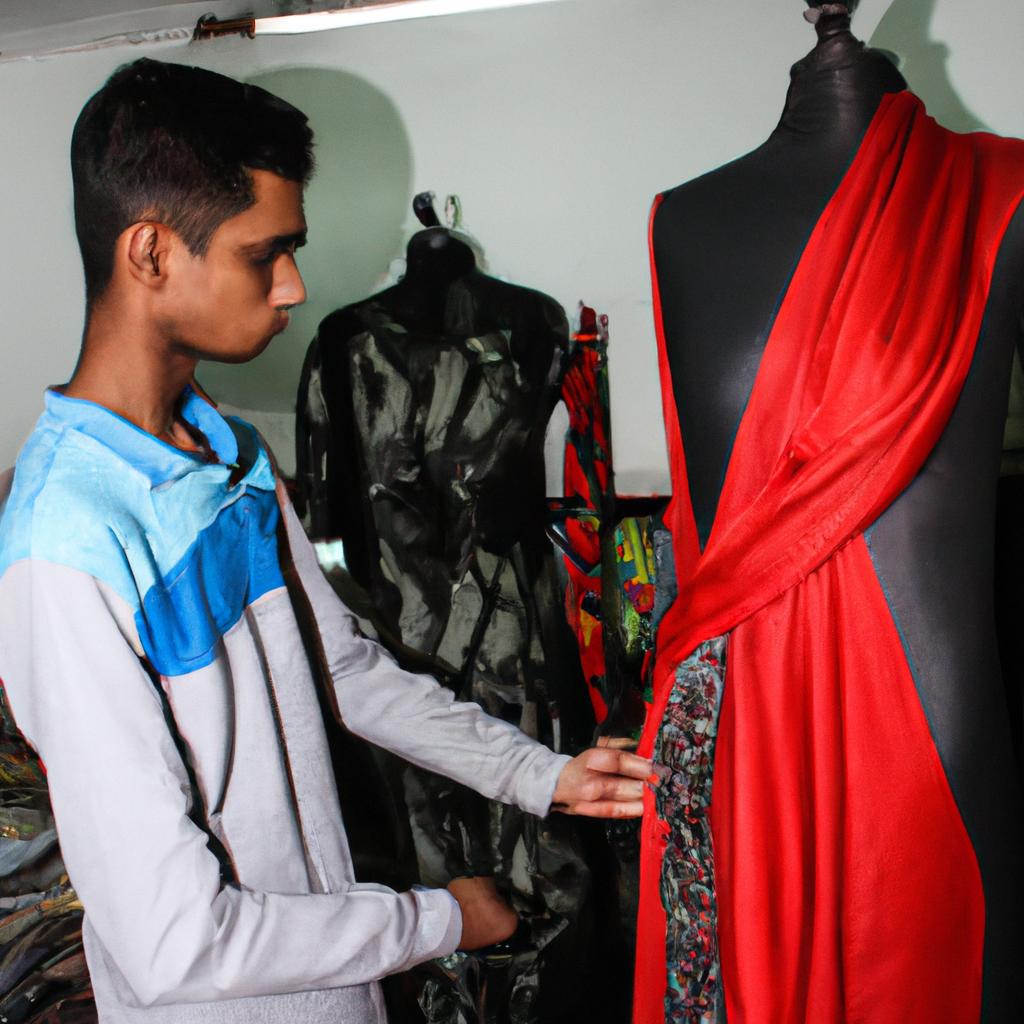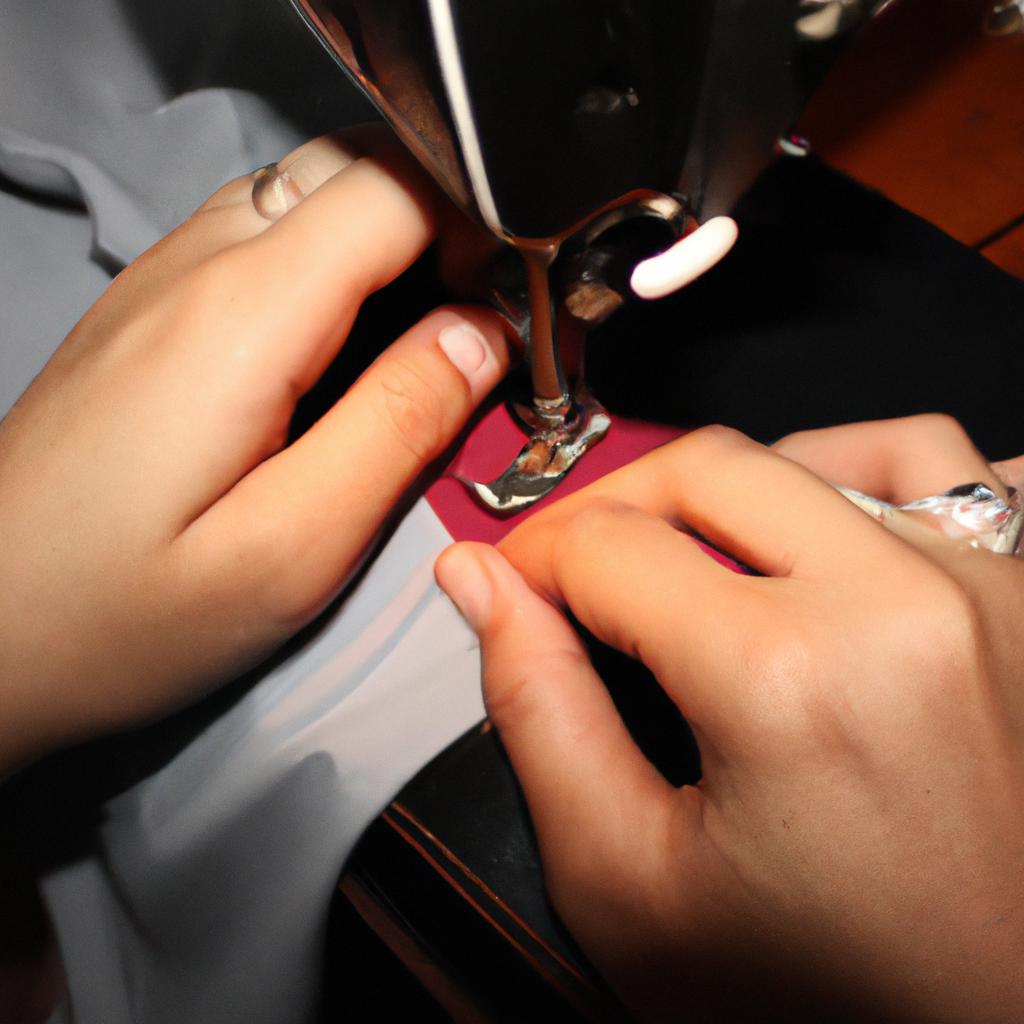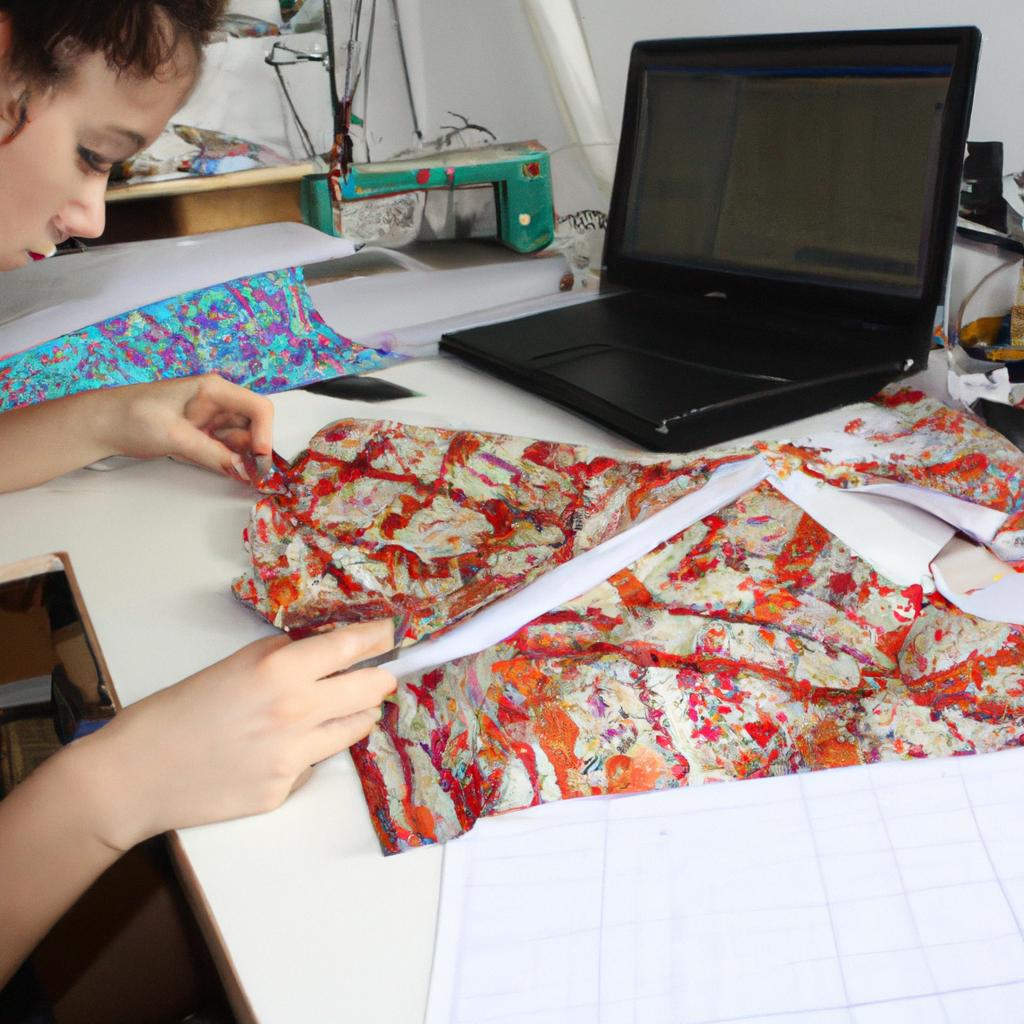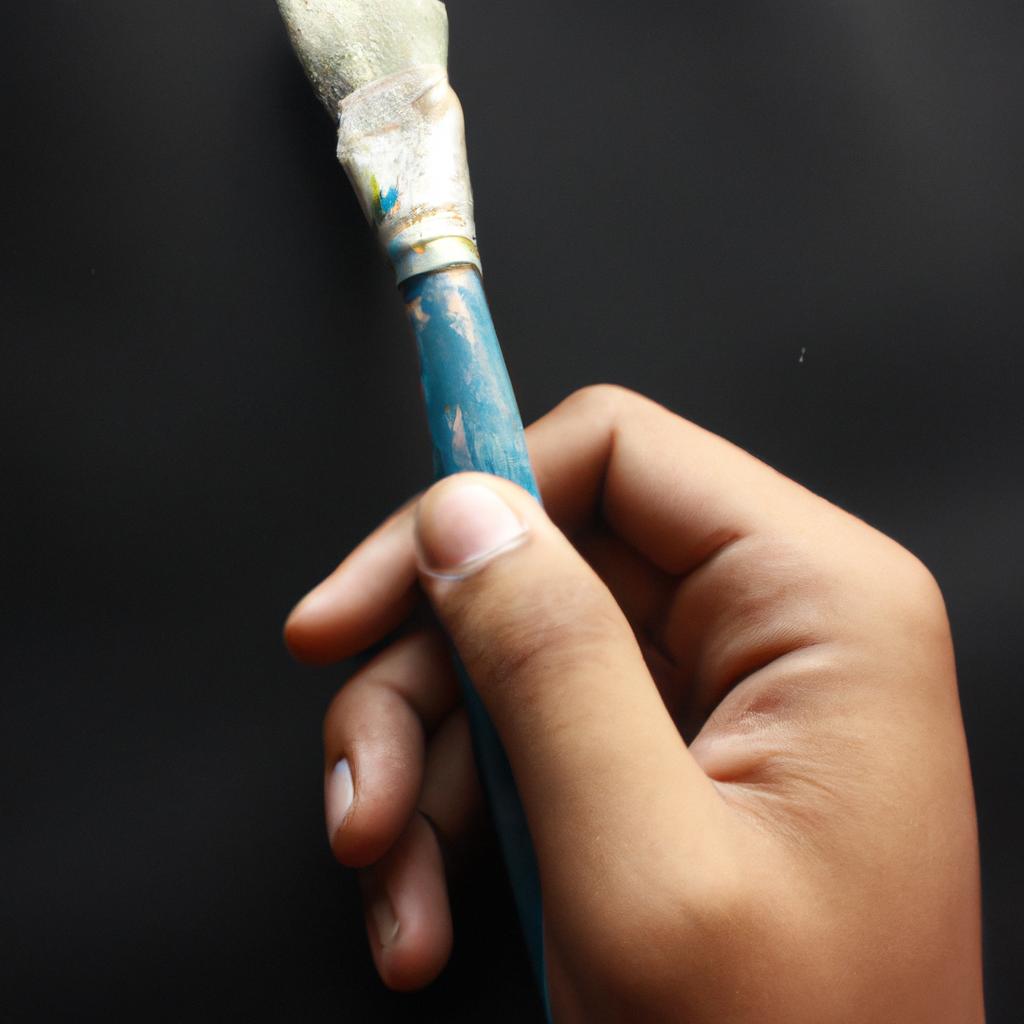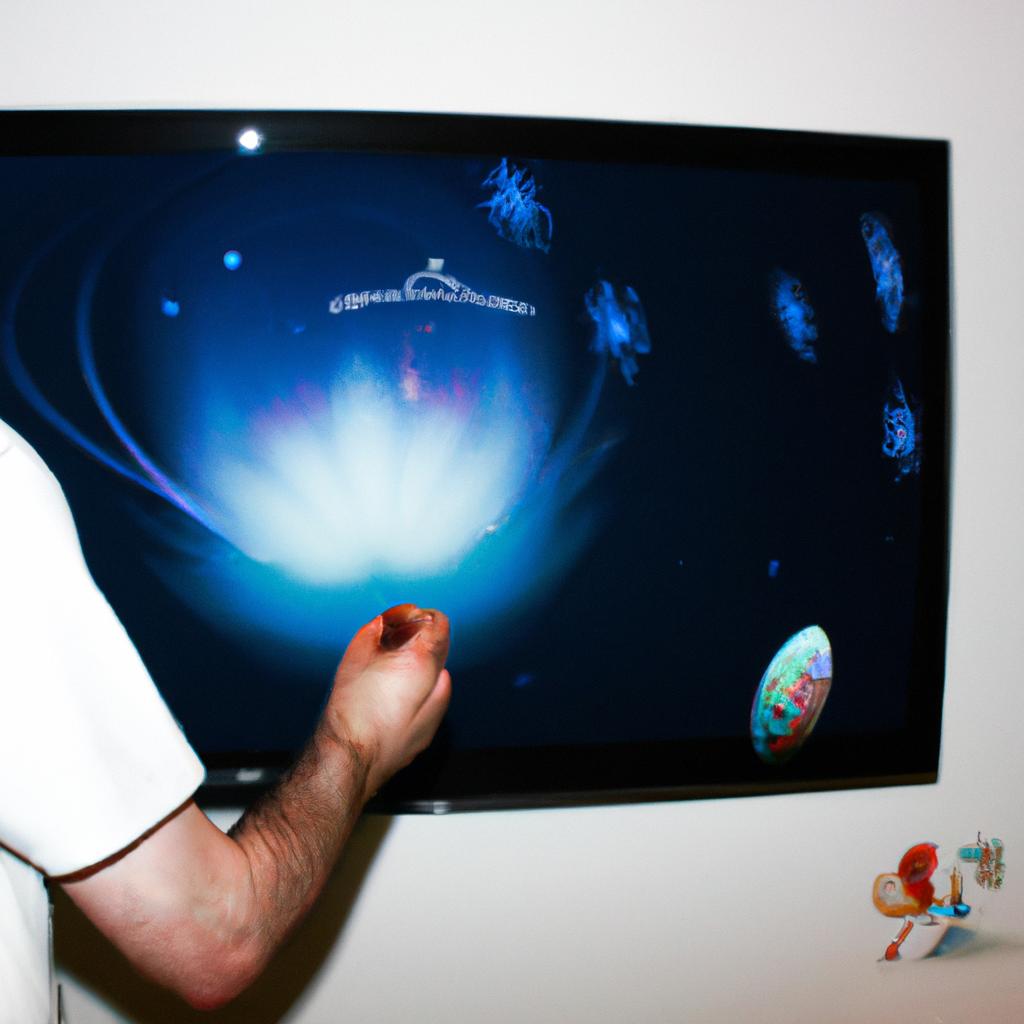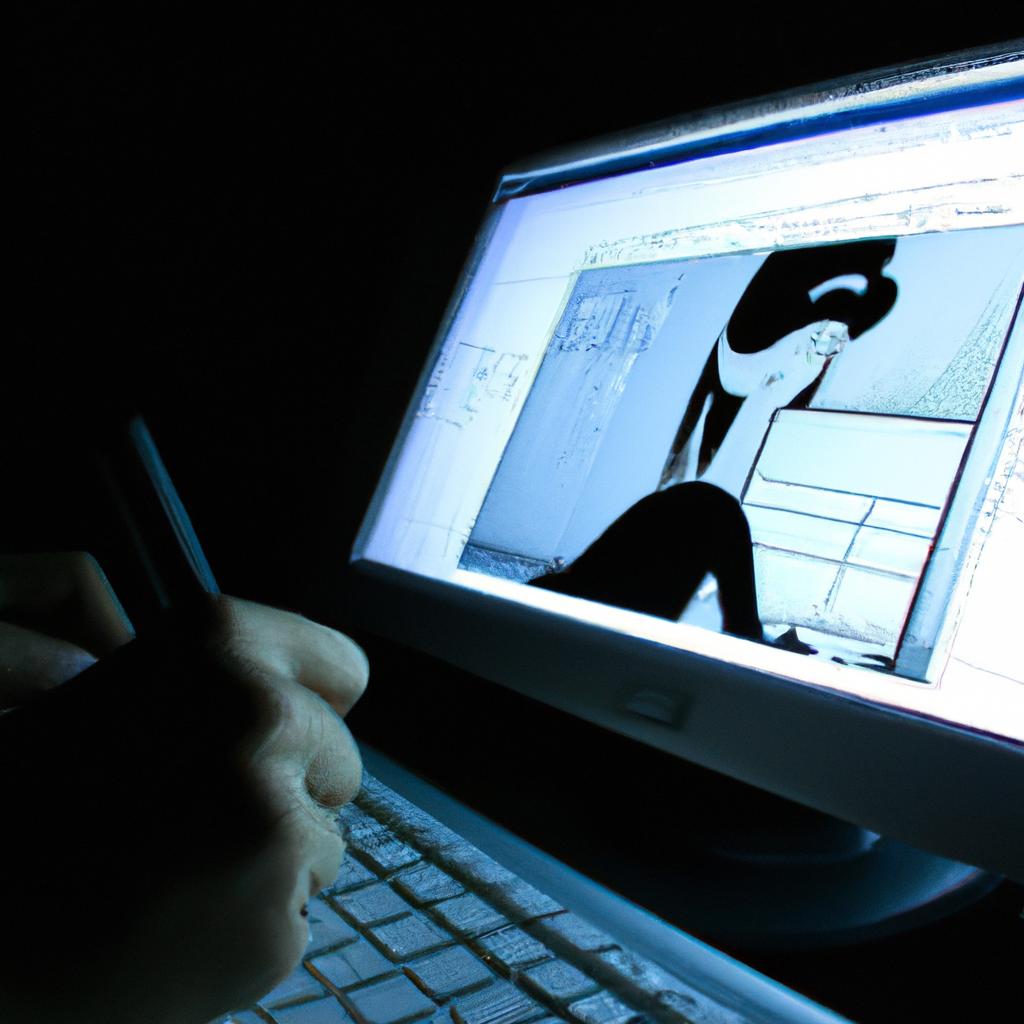Fashion design plays a significant role in the arts and television, as it helps to create visually captivating characters that enhance storytelling. The combination of Fashion and art has been showcased through various mediums, such as films, TV shows, and even theatrical performances. For instance, consider the case of a popular period drama set in the 1920s where meticulous attention is paid to the clothing choices of each character. The costumes not only reflect the societal norms and values of that era but also provide subtle cues about the personalities and motivations of the individuals portrayed on screen.
The influence of fashion design goes beyond mere aesthetics; it serves as a powerful tool for artists to convey deeper meanings and messages through their work. In this article, we will explore how fashion designers collaborate with directors, writers, and other creative professionals to bring characters to life through their sartorial choices. We will delve into the intricate process behind costume design, examining its impact on character development and narrative progression. Additionally, we will analyze notable examples from both historical periods and contemporary productions to shed light on how fashion can be an integral component in enhancing visual storytelling. By understanding these dynamics, we can gain a comprehensive perspective on the multifaceted relationship between fashion design and the realms of arts and television.
Understanding the Role of Color in Fashion
Color plays a crucial role in fashion, as it has the power to evoke emotions, convey messages, and create visual impact. By carefully selecting and combining colors, designers can transform garments into works of art that reflect both personal style and cultural trends. In this section, we will explore the significance of color in fashion through an analysis of its psychological effects and practical applications.
The Psychological Effects of Color:
One example that illustrates the influence of color in fashion is the use of red in formal evening gowns. The vibrant hue often symbolizes passion, power, and confidence, making it a popular choice for individuals who seek to make a bold statement at special events. Furthermore, research suggests that different shades of red can elicit varying emotional responses; while darker tones may exude elegance and sophistication, brighter shades might communicate energy and excitement.
- Colors such as blue and green are commonly associated with tranquility and nature.
- Warm tones like yellow and orange tend to inspire feelings of warmth and joy.
- Neutrals such as black and white connote simplicity or formality depending on context.
- Pastel hues often evoke softness and femininity.
Practical Applications:
Designers apply their understanding of color psychology by strategically incorporating various hues into their collections. To demonstrate this approach visually, here is an example table showcasing three columns representing primary colors (red, blue, yellow) alongside four rows displaying complementary secondary colors (orange-red, purple-blue, green-yellow).
| Red | Blue | Yellow | |
|---|---|---|---|
| Orange-red | |||
| Purple-blue | |||
| Green-yellow | |||
| Neutral |
By juxtaposing complementary colors, designers can create striking visual contrasts that capture attention and accentuate specific elements of their designs. This technique enhances the overall aesthetic appeal of fashion pieces and allows for greater creativity in conveying messages or telling stories through clothing.
In summary, color serves as a powerful tool in the world of fashion, capable of influencing emotions and perceptions. Understanding its psychological effects enables designers to make deliberate choices that align with their artistic vision and resonate with consumers.
Exploring the Influence of Textile Design in Fashion
Color plays a crucial role in fashion, as it has the power to evoke emotions, convey messages, and create visual impact. By carefully selecting and combining colors, fashion designers can enhance their designs and communicate their brand’s identity effectively. One notable example is the iconic red-soled shoes created by Christian Louboutin. The vibrant red color not only adds a touch of luxury but also symbolizes passion and confidence, making it instantly recognizable and highly sought after.
When considering the role of Color in Fashion design, several key points should be taken into account:
-
Color psychology: Different colors have different psychological effects on individuals. For instance, warm tones like red and orange are associated with energy and excitement, while cool tones like blue and green promote calmness and tranquility. Understanding these associations allows designers to intentionally influence how people perceive their garments.
-
Color trends: Fashion is heavily influenced by trends that change over time. Designers need to stay updated with current color trends to ensure their creations resonate with consumers. This involves studying popular palettes showcased at runway shows, analyzing market research data, and monitoring social media platforms where influencers often set new color trends.
-
Cultural significance: Colors hold cultural meanings that vary across different societies around the world. For example, white is traditionally associated with purity in Western cultures but represents mourning in some Eastern cultures. Considering cultural connotations when choosing colors ensures that designs align with diverse audiences’ sensibilities.
-
Brand identity: Color can become an integral part of a brand’s identity, helping distinguish it from competitors and creating recognition among consumers. Think about Tiffany & Co.’s distinct robin egg blue packaging or Hermès’ signature orange boxes; these unique colors have become synonymous with their respective brands.
To better understand the interplay between color theory and fashion design, consider Table 1 below which highlights commonly used colors in fashion along with their corresponding emotions and cultural associations:
Table 1: Colors in Fashion Design
| Color | Emotion | Cultural Association |
|---|---|---|
| Red | Passion, energy | Love, power |
| Blue | Calmness | Trust, serenity |
| Yellow | Happiness | Optimism, brightness |
| Black | Elegance | Mystery, formality |
Patterns are an integral part of fashion design as they add visual interest and uniqueness to garments. By skillfully combining different shapes and motifs, designers can transform plain fabrics into captivating works of art.
Note: The transition from this section to the subsequent one about “The Art of Creating Patterns in Fashion” could be achieved by stating something like “Building upon the foundation of color selection, another crucial aspect of fashion design lies in creating patterns that bring life to garments.”
The Art of Creating Patterns in Fashion
The influence of textile design in the world of fashion is undeniable. This section will delve deeper into how textile design plays a crucial role in shaping the aesthetics and functionality of garments, as well as its impact on the overall creative process.
One prime example that showcases the significance of textile design is seen in designer X’s latest collection. By incorporating hand-painted motifs onto luxurious silk fabric, designer X was able to create unique pieces that seamlessly merged artistry with wearability. The intricate detailing and vibrant colors brought life to the garments, captivating both critics and consumers alike.
In understanding the influence of textile design in fashion, it is important to consider several key factors:
- Material Selection: Different fabrics possess distinct properties, such as drape, weight, and texture. The choice of material greatly affects not only the visual appeal but also determines how a garment moves and feels when worn.
- Print Techniques: From block printing to digital printing, various techniques allow for endless possibilities in pattern creation. Each technique offers different levels of intricacy and precision, enabling designers to express their artistic vision effectively.
- Color Psychology: Colors evoke emotions and convey messages. Skillful use of color palettes can enhance a garment’s intended mood or concept while resonating with the target audience.
- Sustainability Considerations: With an increasing focus on sustainable practices within the fashion industry, textile designers are exploring eco-friendly materials and production methods to minimize environmental impact without compromising creativity.
To further illustrate these points visually:
| Material Selection | Print Techniques | Color Psychology | |
|---|---|---|---|
| 1 | Silk | Block Printing | Bold & Vibrant |
| 2 | Organic Cotton | Digital Printing | Soft & Pastel |
| 3 | Linen | Screen Printing | Neutral & Earthy |
| 4 | Recycled Polyester | Hand-Painting | Monochromatic |
In conclusion, textile design is an essential aspect of fashion that goes beyond mere aesthetics. It influences every stage of the creative process and possesses the power to evoke emotions through material selection, print techniques, color psychology, and sustainable considerations. Understanding these elements allows designers to create garments that not only look visually appealing but also resonate with consumers on a deeper level.
Mastering the Techniques of Garment Construction requires precision and skill in translating innovative designs into wearable pieces.
Mastering the Techniques of Garment Construction
Section Title: The Art of Creating Patterns in Fashion
Building upon the foundation of garment design, fashion designers must possess the skill of creating patterns that bring their creative visions to life. This section will explore the artistry and precision involved in pattern-making, highlighting its importance in achieving well-fitted garments.
Example:
To illustrate the significance of pattern-making, consider a hypothetical scenario where a designer aims to create a structured jacket with intricate pleats. Without carefully crafted patterns, each pleat may appear uneven or misaligned, compromising the overall aesthetic appeal and functionality of the garment. By mastering the art of pattern-making, designers can ensure that their creations not only reflect their artistic vision but also fit seamlessly on various body types.
The art of creating patterns involves several key elements:
-
Precision Measurements:
- Accurate measurements serve as the foundation for successful pattern-making.
- Designers meticulously measure different body parts to translate them into precise dimensions on paper.
- These measurements are crucial in ensuring a perfect fit and harmonious proportions.
-
Technical Drawing Skills:
- Pattern-makers rely on technical drawings to transform conceptual designs into tangible templates.
- Precise lines and markings guide the cutting and sewing processes later on.
- Mastery over technical drawing allows designers to accurately interpret their ideas onto paper before fabric is cut.
-
Understanding Fabric Properties:
- Different fabrics behave differently when draped or manipulated.
- A profound understanding of fabric properties enables pattern-makers to adapt their techniques accordingly.
- Considering factors such as stretch, weight, and texture helps achieve desired results while maintaining structural integrity.
-
Iterative Testing and Adjustments:
- Pattern-making often involves multiple iterations to refine fit and aesthetics.
- Through testing prototypes on dress forms or models, adjustments can be made until the desired outcome is achieved.
- This iterative process ensures that final garments meet both functional requirements and design expectations.
By skillfully incorporating these elements into the pattern-making process, fashion designers can transform their creative ideas into wearable masterpieces that embody both style and functionality.
the power of fashion illustration. This next section will delve into how illustrative techniques contribute to shaping designs, pushing boundaries beyond the realm of patterns alone.
The Power of Fashion Illustration in Design Process
Building upon the mastery of garment construction, fashion designers must also possess a strong foundation in fashion illustration. By utilizing this powerful tool, designers can effectively communicate their creative vision and bring their designs to life before they ever touch a sewing machine or fabric.
Fashion illustration serves as an essential step in the design process, enabling designers to visualize their ideas and make critical decisions on elements such as silhouette, color palette, and detailing. For instance, consider the case study of renowned designer Alexander McQueen. Known for his avant-garde creations, McQueen often sketched intricate illustrations that captured the essence of his imaginative concepts. These sketches served as blueprints for constructing garments that pushed boundaries and challenged conventional norms within the fashion industry.
To fully comprehend the significance of fashion illustration in the design process, it is crucial to explore its various functions:
- Conceptualization: Fashion illustrations allow designers to brainstorm and conceptualize their ideas more effectively than mere verbal descriptions. Through sketching, they can experiment with different shapes, proportions, and styles until they achieve the desired aesthetic.
- Communication: Illustrations serve as a universal language among fashion professionals. Designers use these drawings to convey their visions to pattern makers, seamstresses, and other members of their team who collaborate in bringing their designs to fruition.
- Collaboration: Fashion illustrators not only work closely with designers but also assist photographers, stylists, and art directors during editorial shoots or runway presentations. Their ability to translate concepts into visual representations helps ensure cohesive storytelling throughout each project.
- Marketing: In today’s digital age where social media platforms reign supreme in promoting fashion brands, compelling illustrations play a pivotal role in captivating audiences’ attention while conveying brand identity.
To further illustrate the importance of fashion illustration in contemporary design practices, let us examine how it contributes through comparison using a table format:
| Traditional Design Process | Modern Design Process |
|---|---|
| Sketches are hand-drawn on paper | Sketches are created digitally using software like Adobe Illustrator |
| Physical sketches can be easily lost or damaged | Digital files ensure easy storage and accessibility |
| Limited scope for experimentation due to manual constraints | Endless possibilities for editing, refining, and exploring with digital tools |
| Time-consuming process as modifications require redrawing | Quick revisions made possible through copy-paste, undo-redo functions |
As fashion designers continue to embrace technology and its impact on the industry, it is evident that fashion illustration remains an indispensable component of the design process. By harnessing its power to ideate, communicate, collaborate, and market their creations effectively, designers can truly bring their artistic visions into reality.
Effective Strategies for Fashion Marketing
Building upon the significance of fashion illustration, this section explores effective strategies for fashion marketing. By understanding how to effectively market their designs, fashion designers can maximize their reach and impact within the industry. This section highlights key tactics that have proven successful, emphasizing the importance of a comprehensive marketing approach.
Section:
One example of a successful marketing strategy is utilizing social media platforms to showcase fashion collections. With the rise of digitalization, social media has become an essential tool for reaching wider audiences. For instance, renowned designer X launched their latest collection exclusively on Instagram, generating significant buzz among followers and attracting attention from influential bloggers and celebrities. This case study demonstrates the power of leveraging social media as a promotional platform.
To evoke an emotional response from consumers, it is crucial for designers to consider incorporating storytelling into their marketing campaigns. Storytelling allows brands to establish deeper connections with their target audience by creating narratives around their products or brand ethos. When successfully executed, this technique fosters emotional engagement and loyalty from customers who resonate with the brand’s story. Consider these elements when crafting compelling stories:
- Authenticity: Craft narratives that reflect the core values and identity of the brand.
- Emotion: Evoke feelings such as joy, inspiration, or empowerment through storytelling.
- Visual Appeal: Utilize captivating visuals like imagery or videos to enhance storytelling.
- Consistency: Maintain consistency across all marketing channels to reinforce brand messaging.
In addition to storytelling techniques, collaborating with influencers has emerged as another powerful strategy in contemporary fashion marketing. Influencers possess substantial online followings and are seen as trusted authorities in specific niches. By partnering with relevant influencers whose style aligns with their brand image, fashion designers can tap into existing fan bases while gaining exposure to new potential customers. This collaborative approach allows for increased brand visibility and credibility within the fashion industry.
With an understanding of effective marketing strategies, the next section delves into exploring the psychological effects of colors in fashion. By comprehending how color choices impact consumer perceptions, designers can make informed decisions that resonate with their target audience’s emotions and preferences.
[End of Section]
Exploring the Psychological Effects of Colors in Fashion
Building on the effective strategies for fashion marketing, it is crucial to explore the psychological effects of colors in fashion. By understanding how colors can influence consumer behavior and perception, fashion designers can make informed decisions when creating their collections. To illustrate this concept, let us consider a hypothetical case study involving two different clothing brands targeting young adults.
In this case study, Brand A predominantly uses bright and vibrant colors in its designs, while Brand B opts for more muted and neutral tones. When observing the target audience’s response to these brands, an interesting trend emerges. The consumers associated with Brand A often report feeling energized and confident when wearing their products. On the other hand, those aligned with Brand B express feelings of calmness and sophistication. This example highlights how color choices can evoke unique emotional responses from individuals.
To delve further into the impact of colors in fashion, let us examine some key factors that contribute to these psychological effects:
- Cultural Influences: Different cultures attach varying meanings to colors. For instance, red symbolizes good fortune and celebration in many Asian cultures but may represent danger or warning in Western societies.
- Personal Associations: Individuals develop personal associations with certain colors based on past experiences or preferences. These associations greatly influence how they interpret and respond emotionally to different hues.
- Color Combinations: Combining multiple colors in a design can create contrasting or harmonious visual effects. Certain combinations elicit specific emotions; for example, pairing blue with yellow evokes feelings of happiness and optimism.
- Contextual Relevance: Colors must also align with the intended message or theme of a collection. Using somber shades for formal attire might convey elegance and seriousness, whereas bold hues could be employed for casual wear to exude vibrancy and playfulness.
Table: Psychological Effects of Colors
| Color | Emotional Response |
|---|---|
| Red | Passion |
| Blue | Calmness |
| Yellow | Happiness |
| Green | Harmony |
Understanding the psychological effects of colors in fashion empowers designers to create collections that resonate with their target audience on a deeper level. By strategically selecting and combining colors, they can evoke specific emotions and reinforce brand identity. This knowledge serves as a valuable tool for establishing strong connections between fashion brands and consumers.
Moving forward, we will explore innovative approaches to textile design in modern fashion, where creativity intertwines with technology to push boundaries and redefine industry standards
Innovative Approaches to Textile Design in Modern Fashion
Colors play a significant role in fashion, not only for aesthetic purposes but also for their psychological impact on individuals. Understanding how different colors evoke specific emotions and perceptions can greatly influence fashion design choices. For instance, imagine a scenario where a designer wants to create a collection that exudes confidence and power. By strategically incorporating bold red hues into their designs, they can elicit feelings of strength and assertiveness among wearers.
When it comes to color psychology in fashion, several key elements come into play:
-
Warm vs Cool Tones:
- Warm tones such as reds, oranges, and yellows tend to evoke energy, enthusiasm, and excitement.
- In contrast, cool tones like blues, greens, and purples are associated with calmness, serenity, and relaxation.
-
Cultural Influences:
- Different cultures may have varying interpretations of colors.
- While white symbolizes purity in Western culture, it represents mourning in some Eastern cultures.
-
Personal Associations:
- Individuals often associate colors with personal experiences or cultural symbols.
- For example, blue might remind someone of the ocean or signify trustworthiness due to its association with police uniforms.
-
Color Combinations:
- Combining multiple colors can enhance or alter the emotional response evoked by each individual color.
- The choice of complementary or contrasting colors can create harmony or tension within a garment’s overall design.
To further illustrate these concepts:
| Emotion | Color | Example |
|---|---|---|
| Excitement | Red | A vibrant red dress that exudes confidence and passion. |
| Tranquility | Blue | A serene blue blouse that promotes calmness and relaxation. |
| Creativity | Purple | An imaginative purple suit that sparks inspiration and originality. |
Considering these factors, designers can strategically utilize colors to convey specific emotions and create a desired atmosphere through their fashion creations. By understanding the psychological effects of various hues, they can effectively communicate messages and evoke emotional responses from wearers.
With an understanding of how color influences perceptions in fashion, it is important to explore innovative approaches to textile design that complement these choices. The next section will delve into the use of modern techniques for creating unique fabric patterns that further enhance the overall aesthetic appeal of fashion designs.
Utilizing Pattern Making Techniques for Unique Designs
Innovative Approaches to Textile Design in Modern Fashion have revolutionized the way designers create unique and captivating garments. By exploring new techniques and materials, fashion designers are able to push boundaries and offer fresh perspectives in their designs. One such approach is the use of digital printing on textiles, which allows for intricate patterns and vibrant colors that were previously unachievable.
For instance, let us consider a hypothetical case study where a fashion designer wanted to create a collection inspired by nature. Instead of relying solely on traditional textile design methods, they decided to experiment with digital printing technology. Using high-resolution images of flowers and plants as inspiration, they digitally manipulated these images into stunning patterns that could be printed directly onto fabric. The result was a collection that captured the beauty and essence of nature in an entirely new and innovative way.
The use of digital printing is just one example of how modern fashion designers are pushing the boundaries of textile design. Here are some other innovative approaches being implemented:
- Laser cutting: This technique involves using lasers to cut precise patterns or shapes into fabric. It offers endless possibilities for creating intricate details or even 3D effects.
- LED integration: Incorporating LEDs into textiles adds an element of interactivity and visual interest. Garments can now light up or change color depending on external factors like sound or movement.
- Smart fabrics: These textiles are embedded with sensors or conductive fibers, allowing them to interact with the wearer’s body or environment. They can monitor vital signs, adjust temperature, or even capture energy from movement.
To further illustrate the impact of innovative textile design in modern fashion, we present a table showcasing four iconic garments that have utilized these techniques:
| Garment | Innovation |
|---|---|
| Iris van Herpen | 3D-printed dress |
| Hussein Chalayan | LED-integrated runway |
| Issey Miyake | Pleats Please collection |
| Alexander McQueen | Laser-cut lace gown |
These examples demonstrate the transformative power of pushing the boundaries of textile design in modern fashion. By embracing innovative approaches, designers have been able to create garments that captivate audiences and challenge traditional notions of what clothing can be.
Moving forward, we will delve into another aspect of fashion design: Exploring Advanced Garment Construction Methods. This section will showcase techniques used by designers to construct intricate and unique garments, allowing them to bring their creative visions to life on the runway.
Exploring Advanced Garment Construction Methods
Building upon the foundation of fashion design, pattern making techniques play a crucial role in creating unique and innovative garments. By manipulating patterns to fit specific body shapes and incorporating creative elements, designers are able to bring their visions to life. This section will explore the various ways in which pattern making techniques can be utilized to achieve distinctive designs.
One example that highlights the significance of pattern making is the case study of a renowned designer who aimed to create a collection inspired by architectural structures. Through careful analysis and deconstruction of building blueprints, the designer was able to translate intricate details into pattern pieces. By strategically merging different patterns together, they were able to construct garments that mimicked the fluid lines and geometric forms found in architecture.
To further emphasize the importance of pattern making techniques, here are some key considerations when using them:
- Proportions: Adjusting patterns according to individual body proportions ensures proper fit and enhances overall aesthetics.
- Seam Placement: Strategically placing seams allows for interesting visual effects and emphasizes design features.
- Darts and Pleats: Skillfully incorporating darts and pleats not only adds depth and dimension but also helps shape fabric around the body.
- Fabric Manipulation: Experimenting with folding, gathering, or layering fabric creates texture variations and adds an element of surprise.
Through these thoughtful approaches to pattern making, designers can elevate their creations beyond conventional styles while maintaining functionality. To illustrate this notion further, consider the following table showcasing four distinct garment designs along with their corresponding pattern manipulation techniques:
| Garment Design | Pattern Manipulation Techniques |
|---|---|
| Evening Gown | Asymmetrical seam placement |
| Tailored Blazer | Dart manipulation for tailored silhouette |
| Ruffled Skirt | Gathering technique for voluminous effect |
| Draped Top | Folded fabric for elegant draping |
By incorporating these techniques, designers can create visually striking garments that captivate the audience and evoke emotional responses. The manipulation of patterns allows for a harmonious balance between artistic expression and technical skill.
In preparation for the subsequent section on “The Intersection of Fashion Illustration and Digital Media,” it is important to recognize how pattern making serves as a fundamental step in the design process. Through its utilization, designers are able to translate their ideas into tangible garments, setting the stage for further exploration at the intersection of fashion illustration and digital media.
The Intersection of Fashion Illustration and Digital Media
Exploring Advanced Garment Construction Methods has provided us with a deeper understanding of the intricate techniques used in fashion design. Now, let’s delve into another fascinating aspect: the intersection of Fashion Illustration and Digital Media. To illustrate this concept, imagine a scenario where a renowned fashion designer is creating their latest collection using cutting-edge technology.
In our hypothetical case study, the designer begins by sketching their ideas on paper, capturing the essence of each garment through traditional illustration methods. However, instead of solely relying on these drawings as references, they turn to digital media for further exploration and refinement.
The integration of Fashion Illustration and Digital Media offers numerous advantages:
- Increased Efficiency: By leveraging digital software, designers can easily manipulate and experiment with various colors, patterns, and textures without wasting physical resources.
- Enhanced Visualization: Through 3D modeling and rendering techniques, designers can bring their illustrations to life virtually, enabling them to visualize how different fabrics will drape or how garments will look from various angles.
- Streamlined Collaboration: With digital platforms facilitating remote collaboration among teams located in different parts of the world, designers can seamlessly exchange ideas and receive feedback in real-time.
- Sustainable Practices: Embracing digital tools reduces paper consumption while promoting eco-friendly practices within the industry.
To better understand the impact of this intersection between Fashion Illustration and Digital Media, consider the following table showcasing its benefits:
| Benefits | Description |
|---|---|
| Improved Time Management | Designers can save time by quickly iterating designs digitally rather than starting from scratch every time |
| Realistic Visualization | The ability to create realistic 3D renderings helps designers accurately represent their vision before production |
| Global Collaboration Opportunities | Digital platforms enable seamless collaboration across borders, allowing diverse perspectives to shape the final outcome |
| Environmental Sustainability | By reducing paper waste and embracing sustainable practices like virtual fittings, fashion design becomes more eco-friendly |
As we can see, the integration of Fashion Illustration and Digital Media revolutionizes various aspects of the industry, including creativity, efficiency, collaboration, and sustainability. This intersection serves as a testament to the ever-evolving nature of fashion design.
Now that we have explored Fashion Illustration and Digital Media, our journey through the multifaceted world of fashion continues with an examination of “Fashion Marketing: Building Brand Identity and Awareness.” Here, we will explore how brands establish themselves in this highly competitive landscape, captivating audiences while showcasing their unique style.
Fashion Marketing: Building Brand Identity and Awareness
Having explored the symbiotic relationship between fashion illustration and digital media, we now turn our attention to the vital aspect of fashion marketing. In this section, we will delve into how effective marketing strategies can be employed to build brand identity and awareness within the ever-evolving world of fashion.
Fashion Marketing Strategies:
To illustrate the significance of fashion marketing, let us consider a hypothetical case study involving a newly established clothing brand called “Ethereal Elegance.” Through strategic brand positioning and innovative marketing techniques, Ethereal Elegance successfully captured the attention of its target audience. This example serves as an exemplification of the power wielded by fashion marketing in shaping consumer perceptions.
Emotional Appeal through Bullet Points:
- Amplifying anticipation through captivating teaser campaigns.
- Utilizing influencers to create a sense of aspirational lifestyle associated with the brand.
- Engaging customers through interactive social media contests.
- Hosting exclusive launch events to foster a sense of exclusivity and desirability.
Table – Key Elements for Successful Fashion Marketing:
| Elements | Description | Impact |
|---|---|---|
| Storytelling | Crafting narratives that resonate with consumers, making them feel connected to the brand’s values | Establishes emotional bond |
| Visuals | Creating visually stunning content that captivates audiences’ attention | Enhances aesthetic appeal |
| Collaboration | Partnering with industry experts or other brands to leverage their credibility and expand reach | Increases brand visibility |
| Data Analysis | Utilizing market research and analytics tools to gain insights on consumer behavior for informed decision-making | Drives targeted marketing strategies |
By employing these elements effectively, fashion marketers can evoke emotional responses in their target audience, fostering a strong brand identity and awareness. The power of storytelling, captivating visuals, collaborations, and data analysis cannot be underestimated when it comes to creating impactful fashion marketing campaigns.
In summary, the art of fashion marketing is integral to establishing a brand’s presence within the industry. By leveraging effective strategies such as those outlined above, brands have the potential to resonate with consumers on an emotional level, ultimately leading to increased visibility and consumer loyalty. Through careful planning and execution, fashion marketers play a vital role in shaping the success of fashion brands in today’s competitive landscape.

